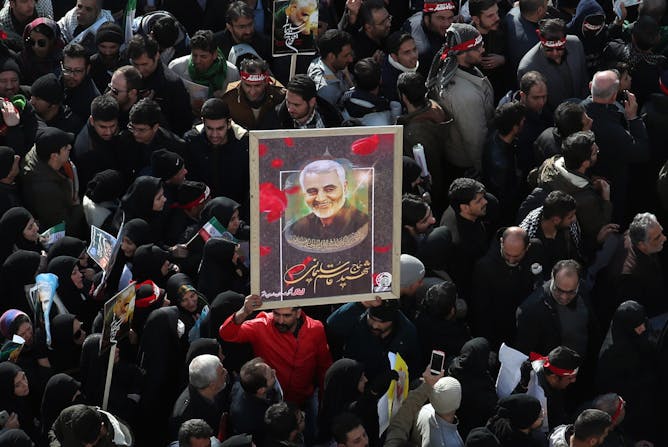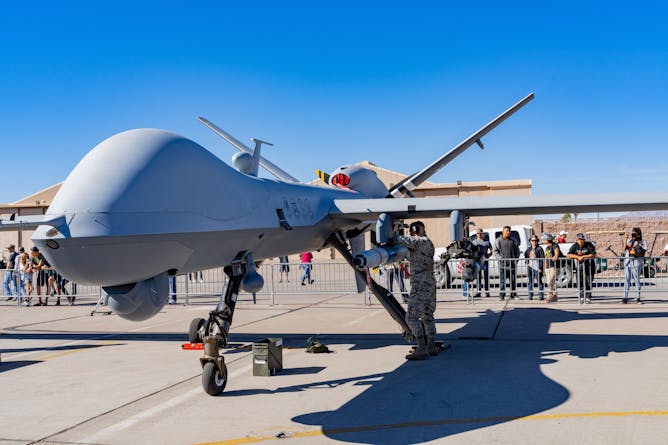|
|
|
Editor's note
|
|
Amid a crush and stampede at the burial of Qassem Soleimani, the Iranian general killed in a US drone strike last week, at least 50 people are reported to have died. The huge crowds paying their respects to Soleimani are a testament to his power and influence across the Middle East. Soleimani was central to Iran’s proxy war strategy, cultivating groups from Iraq to Yemen and Lebanon to Syria to carry out attacks against Iran’s enemies. As Vladimir Rauta explains, Soleimani embodied Iranian military expansionism at its most ruthless by coordinating and sponsoring these militias.
But while these proxies were carefully and strategically supported by Iran, their loyalty does not mean total subservience. They may now act independently as calls for retaliation against the US continue to mount.
In Washington, the chaos in the Trump administration following the strike show a lack of planning for what happens next. But if a full-blown conflict does now explode between the US and Iran, it could escalate very quickly and dangerously. Meanwhile, an expert on the Reaper drones, reportedly used to carry out the strike on Soleimani, explains how they work.
And we bring you four simple rules for how to make your food shop greener and why schools need to equip children with the skills to spot misinformation.
|
Gemma Ware
Global Affairs Editor
|

|
|
Top stories
|

Mourners at the funeral of Qassem Soleimani in Tehran.
Abedin Taherkenareh/EPA
Vladimir Rauta, University of Reading
For decades, Iran has built up a network of proxies across the Middle East. Will it now use them to retailiate for the killing of its top general?
|

Kit Leong/Shutterstock
Peter Lee, University of Portsmouth
The drone used to kill Iranian general Qassem Soleimani doesn't take away all risks and responsibilities from military personnel.
|

Rawpixel.com/Shutterstock
Frances Yeoman, Liverpool John Moores University; Kate Morris, Goldsmiths, University of London
Only 2% of children have the skills needed to identify a credible news story.
|

Alena A/Shutterstock
Luca Panzone, Newcastle University; Natasha Auch, Newcastle University
Plastic packaging isn't always the enemy and don't be fooled by organic labels.
|
Politics + Society
|
-
Scott Lucas, University of Birmingham
Tehran is making threats but its options are somewhat limited.
-
Kate Stewart, Nottingham Trent University; Matthew Cole, The Open University
Ethical veganism is now protected as a 'philosophical belief'. But it's about more than just a plant-based diet.
|
|
Arts + Culture
|
-
Richard Brooks, Coventry University
In 2009, newspapers prophesied the death of the radio drama. However, as of 2020 audio fiction has become the fastest-growing strand in publishing, with tech, media and film companies crowding in.
-
Beth Palmer, University of Surrey
The latest version of Dickens' classic is a refreshingly diverse tale of the triumph of the ordinary heroism over everyday evil.
|
|
|
|
Science + Technology
|
-
Elizabeth Sawchuk, Stony Brook University (The State University of New York); Mary Prendergast, Saint Louis University – Madrid
20 years ago, who could predict how much more researchers would know today about the human past – let alone what they could learn from a thimble of dirt, a scrape of dental plaque, or satellites in space.
|
|
| |
Featured events
|

|
Ron Cooke Hub, Campus East, , York, York, YO10 5GE, United Kingdom of Great Britain and Northern Ireland — University of York
|

|
Bowland Auditorium, Berrick Saul Building, Campus West, York, York, YO10 5DD, United Kingdom of Great Britain and Northern Ireland — University of York
|

|
Room ARC/014, Alcuin Research Resource Centre, Campus West, York, York, YO10 5DD, United Kingdom of Great Britain and Northern Ireland — University of York
|

|
Room SLB/118, Spring Lane Building, Campus West, York, York, YO10 5DD, United Kingdom of Great Britain and Northern Ireland — University of York
|
|
|
|
| |
| |
| |
| |
| |
|
|
|
|
|
|
|